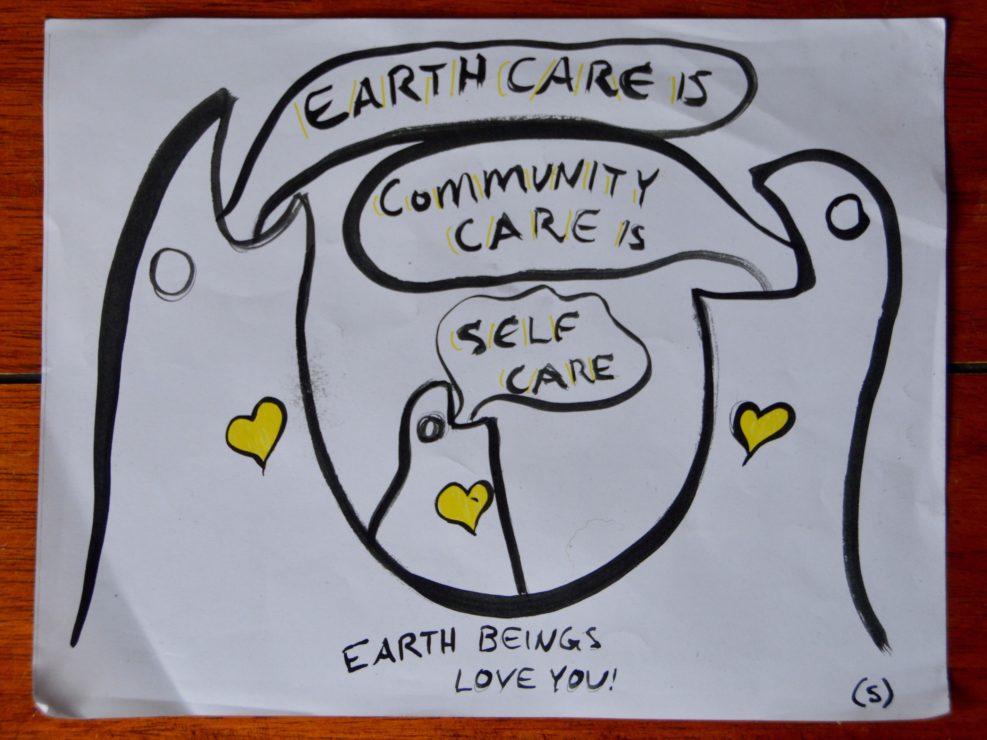Earth care, community care, and self care during COVID-19

As people transition away from their fast-paced lives in offices, classrooms, and studios, a silence falls over concrete jungles across the planet. Sadie Gibbs, a student at the University of Victoria, says “Earth care is community care is self care” in a piece of her own handcrafted art, posted in a Facebook group called COVID-19 Coming Together (Victoria/Lekwungen and W̱SÁNEĆ Lands).
Gibbs is an environmental studies and geography student, and it was her studies that prompted this thinking. Now, she hopes to post her message at bus stops around Victoria.
As a beam of sunlight shines through the window and birds chirp in the backyard, Gibbs and her roommate sit in their kitchen.
“The self is a microcosm of the community, which is a microcosm of Earth,” Gibbs says. “Even self is a microcosm of Earth, and the internal world is a direct reflection of the external world and vice versa.”
According to Gibbs, self care, community care, and Earth care can all be done through gardening.
Only five nautical miles from the Swartz Bay ferry terminal, Meghan De Jong, a nutritionist and gardener, lives on Salt Spring Island.
“I think this year is the best year ever to be considering starting a little patio planter box or your own garden. Whatever that can look like for people, just for food security, as well as mental well-being and connection to the Earth. I think [it] is so important.” says De Jong. She recommends starting with plants such as kale, lettuce, and arugula at this time of year.
The practices of self-compassion, getting outside in nature, and having blood sugar-balancing and hearty meals are important to De Jong. She suggests incorporating protein, carbs, fats, and lots of vegetables into every meal to help with anxiety.
A study conducted in the Netherlands demonstrated that individuals showed a reduction in cortisol and a decrease in their symptoms of stress after having spent 30 minutes gardening.
“Being in the garden almost makes time feel as though [the world is] standing still,” De Jong says. “Despite sometimes requiring hard labour, the tasks feel meditative, therapeutic, and occasionally cathartic.”
The pandemic has prompted individuals to retreat to their homes, adjusting their regular routines from ones that stretch across a city to ones that exist within the walls of a singular building in order to contain the virus.
Despite the constraints of physical distancing, De Jong encourages people to find other ways to build community.
“Right now small acts of kindness can be so big … figuring out what you have [an] abundance [of] and maybe someone else doesn’t,” she says.
Kim Faber, a nurse working on Vancouver Island, says that people are much more aware, and are beginning to consider one another more.
Healthcare workers are working at the front lines of this pandemic. Faber notes that it is important for her to look after herself so that she can keep showing up on the front lines.
When Faber was working on Cape Breton Island, between shifts she would go to the forest, sit with the trees, and hug them.
“While we are keeping our distance from one another we can develop a closeness with nature and sit with a tree,” she says.
As reported by the Canadian Parks Council, Canadians spend 90 per cent of their day indoors. The report, created by the Council to connect Canadians to nature again, says that forging a connection to the natural world strengthens a “sense of self,” and benefits the economy and one’s overall health.
As physical distancing has become a requirement for the containment of COVID-19, Gibbs says that gardening is important. It’s something you can do alone, while you get to enjoy the sunshine, the birds, and look after yourself.
“It’s like painting in a landscape. It’s like edible painting,” she says.
For De Jong, her garden is a blissful scene to walk through. It’s filled with birds singing songs, bees humming all around, and earthworms moving through the soil.
“Being in the garden feels like [one] of the best way[s] to spend my time,” she says.
De Jong reflects on the health benefits of soil and how we can care for our Earth.
“That reciprocal relationship, the more we’re immersed in nature and the more we remember that we’re a part of it,” she says. “I’d say just get back to that connection to the Earth and really truly loving it.”








